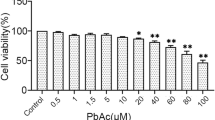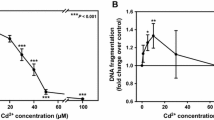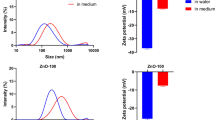Abstract
Nickel and nickel compounds are carcinogens that target the lungs and kidneys causing cell death or cell survival adaptation. The multidrug resistance P-glycoprotein ABCB1 protects cells against toxic metabolites and xenobiotics and is upregulated in many cancer cell types. Here, we investigated the role of ABCB1 in nickel-induced stress signaling mediated by reactive oxygen species (ROS) and ceramides. In renal proximal tubule cells, nickel chloride (0.1–0.25 mM) increased both ROS formation, detected by 5-(and-6)-carboxy-2′,7′-dichlorodihydrofluorescein diacetate, and cellular ceramides, which were determined by lipid dot blot and surface immunostaining, culminating in decreased cell viability, increased DNA fragmentation, augmented PARP-1 cleavage, and increased ABCB1 mRNA and protein. Inhibitors of the de novo ceramide synthesis pathway (fumonisin B1, l-cycloserine) and an antioxidant (α-tocopherol) attenuated nickel-induced toxicity as well as induction of ABCB1. ABCB1 protects against nickel toxicity as PSC833, an ABCB1 blocker, augmented the decrease in cell viability by nickel. Moreover, nickel toxicity was attenuated in renal MDCK cells stably overexpressing ABCB1. In agreement with previous data that demonstrated extrusion of (glucosyl)ceramides by ABCB1 (Lee et al. in Toxicol Sci 121:343, 2011), PSC833 increased total cellular ceramides by >2-fold after nickel treatment. Further, glucosylceramide synthase (GCS) mRNA is upregulated by nickel at 3 h by ~1.5-fold but declined with prolonged exposures (6–24 h). Inhibition of GCS with C9DGJ or knockdown of GCS with siRNA significantly attenuated nickel toxicity. In conclusion, nickel induces a ROS-ceramide pathway to cause apoptotic cell death as well as activate adaptive survival responses, including upregulation of ABCB1, which improves cell survival by extruding proapoptotic (glucosyl)ceramides.





Similar content being viewed by others
References
Arena VC, Sussman NB, Redmond CK, Costantino JP, Trauth JM (1998) Using alternative comparison populations to assess occupation-related mortality risk. Results for the high nickel alloys workers cohort. J Occup Environ Med 40(10):907–916
Baker EK, Johnstone RW, Zalcberg JR, El-Osta A (2005) Epigenetic changes to the MDR1 locus in response to chemotherapeutic drugs. Oncogene 24(54):8061–8075. doi:10.1038/sj.onc.1208955
Baylin SB (2005) DNA methylation and gene silencing in cancer. Nat Clin Pract Oncol 2(Suppl 1):S4–11. doi:10.1038/ncponc0354
Bligh EG, Dyer WJ (1959) A rapid method of total lipid extraction and purification. Can J Biochem Physiol 37(8):911–917
Bork U, Lee WK, Kuchler A, Dittmar T, Thévenod F (2010) Cadmium-induced DNA damage triggers G(2)/M arrest via chk1/2 and cdc2 in p53-deficient kidney proximal tubule cells. Am J Physiol Renal Physiol 298(2):F255–F265. doi:10.1152/ajprenal.00273.2009
Bradford MM (1976) A rapid and sensitive method for the quantitation of microgram quantities of protein utilizing the principle of protein-dye binding. Anal Biochem 72:248–254
Brocato J, Costa M (2013) Basic mechanics of DNA methylation and the unique landscape of the DNA methylome in metal-induced carcinogenesis. Crit Rev Toxicol 43(6):493–514. doi:10.3109/10408444.2013.794769
Cabot MC, Han TY, Giuliano AE (1998) The multidrug resistance modulator SDZ PSC 833 is a potent activator of cellular ceramide formation. FEBS Lett 431(2):185–188
Chakraborty PK, Lee WK, Molitor M, Wolff NA, Thévenod F (2010) Cadmium induces Wnt signaling to upregulate proliferation and survival genes in sub-confluent kidney proximal tubule cells. Mol Cancer 9(1):102. doi:10.1186/1476-4598-9-102
Chen H, Ke Q, Kluz T, Yan Y, Costa M (2006) Nickel ions increase histone H3 lysine 9 dimethylation and induce transgene silencing. Mol Cell Biol 26(10):3728–3737. doi:10.1128/MCB.26.10.3728- 3737.2006
Chin KV, Tanaka S, Darlington G, Pastan I, Gottesman MM (1990) Heat shock and arsenite increase expression of the multidrug resistance (MDR1) gene in human renal carcinoma cells. J Biol Chem 265(1):221–226
Cortijo J, Milara J, Mata M, Donet E, Gavara N, Peel SE, Hall IP, Morcillo EJ (2010) Nickel induces intracellular calcium mobilization and pathophysiological responses in human cultured airway epithelial cells. Chem Biol Interact 183(1):25–33. doi:10.1016/j.cbi.2009.09.011
Costa M (2000) Chromium and nickel. In: Zalups RK, Koropatnick J (eds) Molecular biology and toxicology of metals. Taylor & Francis, London, pp 113–128
Cowart LA, Szulc Z, Bielawska A, Hannun YA (2002) Structural determinants of sphingolipid recognition by commercially available anti-ceramide antibodies. J Lipid Res 43(12):2042–2048
Cruz MT, Goncalo M, Figueiredo A, Carvalho AP, Duarte CB, Lopes MC (2004) Contact sensitizer nickel sulfate activates the transcription factors NF-kB and AP-1 and increases the expression of nitric oxide synthase in a skin dendritic cell line. Exp Dermatol 13(1):18–26. doi:10.1111/j.0906-6705.2004.00105.x
Ding J, He G, Gong W, Wen W, Sun W, Ning B, Huang S, Wu K, Huang C, Wu M, Xie W, Wang H (2009) Effects of nickel on cyclin expression, cell cycle progression and cell proliferation in human pulmonary cells. Cancer Epidemiol Biomarkers Prev 18(6):1720–1729. doi:10.1158/1055-9965.EPI-09-0115
Eckford PD, Sharom FJ (2005) The reconstituted P-glycoprotein multidrug transporter is a flippase for glucosylceramide and other simple glycosphingolipids. Biochem J 389(Pt 2):517–526. doi:10.1042/BJ20050047
Golebiowski F, Kasprzak KS (2005) Inhibition of core histones acetylation by carcinogenic nickel(II). Mol Cell Biochem 279(1–2):133–139. doi:10.1007/s11010-005-8285-1
Gottesman MM, Ling V (2006) The molecular basis of multidrug resistance in cancer: the early years of P-glycoprotein research. FEBS Lett 580(4):998–1009. doi:10.1016/j.febslet.2005.12.060
Gottesman MM, Fojo T, Bates SE (2002) Multidrug resistance in cancer: role of ATP-dependent transporters. Nat Rev Cancer 2(1):48–58. doi:10.1038/nrc706
Grassme H, Jekle A, Riehle A, Schwarz H, Berger J, Sandhoff K, Kolesnick R, Gulbins E (2001) CD95 signaling via ceramide-rich membrane rafts. J Biol Chem 276(23):20589–20596. doi:10.1074/jbc.M101207200
Gupta SC, Hevia D, Patchva S, Park B, Koh W, Aggarwal BB (2012) Upsides and downsides of reactive oxygen species for cancer: the roles of reactive oxygen species in tumorigenesis, prevention, and therapy. Antioxid Redox Signal 16(11):1295–1322. doi:10.1089/ars.2011.4414
Hanahan D, Weinberg RA (2011) Hallmarks of cancer: the next generation. Cell 144(5):646–674. doi:10.1016/j.cell.2011.02.013
Handlogten ME, Shiraishi N, Awata H, Huang C, Miller RT (2000) Extracellular Ca(2 +)-sensing receptor is a promiscuous divalent cation sensor that responds to lead. Am J Physiol Renal Physiol 279(6):F1083–F1091
Hannun YA, Obeid LM (2008) Principles of bioactive lipid signalling: lessons from sphingolipids. Nat Rev Mol Cell Biol 9(2):139–150. doi:10.1038/nrm2329
Hartmann D, Lucks J, Fuchs S, Schiffmann S, Schreiber Y, Ferreiros N, Merkens J, Marschalek R, Geisslinger G, Grosch S (2012) Long chain ceramides and very long chain ceramides have opposite effects on human breast and colon cancer cell growth. Int J Biochem Cell Biol 44(4):620–628. doi:10.1016/j.biocel.2011.12.019
IARC (2012) Nickel and Nickel Compounds. A review of human carcinogens. Part C: Arsenic, metals, fibres, and dusts/IARC Working Group on the Evaluation of Carcinogenic Risks to Humans (2009: Lyon, France), vol 100C. International Agency for Research on Cancer, Lyon, France
Kasprzak KS, Jaruga P, Zastawny TH, North SL, Riggs CW, Olinski R, Dizdaroglu M (1997) Oxidative DNA base damage and its repair in kidneys and livers of nickel(II)-treated male F344 rats. Carcinogenesis 18(2):271–277
Kasprzak KS, Sunderman FW Jr, Salnikow K (2003) Nickel carcinogenesis. Mutat Res 533(1–2):67–97
Kaur P, Dani HM (2003) Carcinogenicity of nickel is the result of its binding to RNA and not to DNA. J Environ Pathol Toxicol Oncol 22(1):29–39
Lee SH, Choi JG, Cho MH (2001) Apoptosis, bcl2 expression, and cell cycle analyses in nickel(II)-treated normal rat kidney cells. J Korean Med Sci 16(2):165–168
Lee WK, Torchalski B, Thévenod F (2007) Cadmium-induced ceramide formation triggers calpain-dependent apoptosis in cultured kidney proximal tubule cells. Am J Physiol Cell Physiol 293(3):C839–C847
Lee WK, Torchalski B, Kohistani N, Thévenod F (2011) ABCB1 Protects Kidney Proximal Tubule Cells Against Cadmium-Induced Apoptosis: roles of Cadmium and Ceramide Transport. Toxicol Sci 121(2):343–356. doi:10.1093/toxsci/kfr071
Lee WK, Chakraborty PK, Roussa E, Wolff NA, Thévenod F (2012) ERK1/2-dependent bestrophin-3 expression prevents ER-stress-induced cell death in renal epithelial cells by reducing CHOP. Biochim Biophys Acta 1823(10):1864–1876. doi:10.1016/j.bbamcr.2012.06.003
Lee WK, Chakraborty PK, Thévenod F (2013) Pituitary homeobox 2 (PITX2) protects renal cancer cell lines against doxorubicin toxicity by transcriptional activation of the multidrug transporter ABCB1. Int J Cancer 133(3):556–567. doi:10.1002/ijc.28060
Littlefield NA, Fullerton FR, Poirier LA (1991) Hydroxylation and deglycosylation of 2′-deoxyguanosine in the presence of magnesium and nickel. Chem Biol Interact 79(2):217–228
Liu YY, Han TY, Giuliano AE, Cabot MC (2001) Ceramide glycosylation potentiates cellular multidrug resistance. FASEB J 15(3):719–730. doi:10.1096/fj.00-0223com
Mesicek J, Lee H, Feldman T, Jiang X, Skobeleva A, Berdyshev EV, Haimovitz-Friedman A, Fuks Z, Kolesnick R (2010) Ceramide synthases 2, 5, and 6 confer distinct roles in radiation-induced apoptosis in HeLa cells. Cell Signal 22(9):1300–1307. doi:10.1016/j.cellsig.2010.04.006
Park MA, Mitchell C, Zhang G, Yacoub A, Allegood J, Haussinger D, Reinehr R, Larner A, Spiegel S, Fisher PB, Voelkel-Johnson C, Ogretmen B, Grant S, Dent P (2010) Vorinostat and sorafenib increase CD95 activation in gastrointestinal tumor cells through a Ca(2 +)-de novo ceramide-PP2A-reactive oxygen species-dependent signaling pathway. Cancer Res 70(15):6313–6324. doi:10.1158/0008-5472.CAN-10-0999
Perry DK, Bielawska A, Hannun YA (2000) Quantitative determination of ceramide using diglyceride kinase. Methods Enzymol 312:22–31
Salnikow K, An WG, Melillo G, Blagosklonny MV, Costa M (1999a) Nickel-induced transformation shifts the balance between HIF-1 and p53 transcription factors. Carcinogenesis 20(9):1819–1823
Salnikow K, Kluz T, Costa M (1999b) Role of Ca(2 +) in the regulation of nickel-inducible Cap43 gene expression. Toxicol Appl Pharmacol 160(2):127–132. doi:10.1006/taap 1999.8759
Schinkel AH, Kemp S, Dolle M, Rudenko G, Wagenaar E (1993) N-glycosylation and deletion mutants of the human MDR1 P-glycoprotein. J Biol Chem 268(10):7474–7481
Scotto KW (2003) Transcriptional regulation of ABC drug transporters. Oncogene 22(47):7496–7511. doi:10.1038/sj.onc.1206950
Severa J, Vyskocil A, Fiala Z, Cizkova M (1995) Distribution of nickel in body fluids and organs of rats chronically exposed to nickel sulphate. Hum Exp Toxicol 14(12):955–958
Smith JC, Hackley B (1968) Distribution and excretion of nickel-63 administered intravenously to rats. J Nutr 95(4):541–546
Sunderman FW Jr, Maenza RM, Hopfer SM, Mitchell JM, Allpass PR, Damjanov I (1979) Induction of renal cancers in rats by intrarenal injection of nickel subsulfide. J Environ Pathol Toxicol 2(6):1511–1527
Tchou-Wong KM, Kiok K, Tang Z, Kluz T, Arita A, Smith PR, Brown S, Costa M (2011) Effects of nickel treatment on H3K4 trimethylation and gene expression. PLoS One 6(3):e17728. doi:10.1371/journal.pone.0017728
Thévenod F, Friedmann JM, Katsen AD, Hauser IA (2000) Up-regulation of multidrug resistance P-glycoprotein via nuclear factor-kappaB activation protects kidney proximal tubule cells from cadmium- and reactive oxygen species-induced apoptosis. J Biol Chem 275(3):1887–1896
Thévenod F, Wolff NA, Bork U, Lee WK, Abouhamed M (2007) Cadmium induces nuclear translocation of beta-catenin and increases expression of c-myc and Abcb1a in kidney proximal tubule cells. Biometals 20(5):807–820. doi:10.1007/s10534-006-9044-9
Toth M, Boros IM, Balint E (2012) Elevated level of lysine 9-acetylated histone H3 at the MDR1 promoter in multidrug-resistant cells. Cancer Sci 103(4):659–669. doi:10.1111/j.1349-7006.2012.02215.x
Vielhaber G, Brade L, Lindner B, Pfeiffer S, Wepf R, Hintze U, Wittern KP, Brade H (2001) Mouse anti-ceramide antiserum: a specific tool for the detection of endogenous ceramide. Glycobiology 11(6):451–457
Wang YF, Shyu HW, Chang YC, Tseng WC, Huang YL, Lin KH, Chou MC, Liu HL, Chen CY (2012) Nickel (II)-induced cytotoxicity and apoptosis in human proximal tubule cells through a ROS- and mitochondria-mediated pathway. Toxicol Appl Pharmacol 259(2):177–186. doi:10.1016/j.taap.2011.12.022
Wartenberg M, Ling FC, Muschen M, Klein F, Acker H, Gassmann M, Petrat K, Putz V, Hescheler J, Sauer H (2003) Regulation of the multidrug resistance transporter P-glycoprotein in multicellular tumor spheroids by hypoxia-inducible factor (HIF-1) and reactive oxygen species. FASEB J 17(3):503–505. doi:10.1096/fj.02-0358fje
Won JS, Singh I (2006) Sphingolipid signaling and redox regulation. Free Radic Biol Med 40(11):1875–1888. doi:10.1016/j.freeradbiomed.2006.01.035
Yang Y, Karakhanova S, Werner J, Bazhin AV (2013) Reactive oxygen species in cancer biology and anticancer therapy. Curr Med Chem 20(30):3677–3692
Acknowledgments
We thank Dr. Michael M. Gottesman (Laboratory of Cell Biology, National Cancer Institute, Bethesda, MD) and Dr. Ulrich Hopfer (Department of Physiology & Biophysics, Case Western Reserve University, Cleveland, OH) for providing ABCB1-MDCK and rat proximal tubule cell lines, respectively, Sanofi-Aventis for providing PSC833, and B. Scharner and S. Probst for expert technical assistance. F.D. received a fellowship from the Algerian Ministry for Higher Education. This work was funded by a University of Witten/Herdecke internal research program grant (to W.-K.L), the Westermann-Westdorp Foundation (to W.-K.L) and the Deutsche Forschungsgemeinschaft (TH345 10-1 and 11-1 to F.T.).
Conflicts of interest
None.
Author information
Authors and Affiliations
Corresponding author
Rights and permissions
About this article
Cite this article
Dahdouh, F., Raane, M., Thévenod, F. et al. Nickel-induced cell death and survival pathways in cultured renal proximal tubule cells: roles of reactive oxygen species, ceramide and ABCB1. Arch Toxicol 88, 881–892 (2014). https://doi.org/10.1007/s00204-014-1194-x
Received:
Accepted:
Published:
Issue Date:
DOI: https://doi.org/10.1007/s00204-014-1194-x




